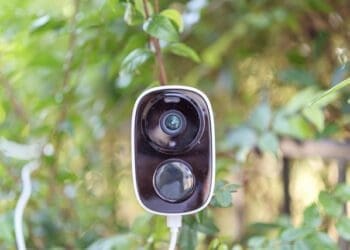We’ve all heard the saying, “Better safe than sorry,” and when it comes to our homes, this couldn’t be more true. In today’s world, security cameras have become an essential part of smart home security, offering peace of mind and protection for our families and property. With advancements in technology, these cameras now do more than just record video – they’ve become intelligent systems that can detect motion, send alerts, and even integrate with other smart home devices.
In this article, we’ll explore the world of security cameras and how they can upgrade your smart home. We’ll look at the top features to consider when choosing home security cameras, compare the best indoor and outdoor options, and discuss the pros and cons of wireless and wired systems. We’ll also dive into how to integrate these cameras with your existing smart home setup and address important privacy concerns. By the end, you’ll have all the information you need to make an informed decision about the right security camera system for your home.
Top Features to Look for in Smart Security Cameras

When we’re upgrading our smart homes with security cameras, it’s crucial to know what features to look for. These cameras are more than just recording devices; they’re intelligent systems that can enhance our home security in ways we might not have imagined. Let’s explore some of the top features that make smart security cameras a must-have for any modern home.
High-Resolution Video
One of the most important features to consider is the camera’s resolution. We want our security footage to be clear and detailed, especially if we need to identify faces or license plates. High-resolution cameras capture more pixels, resulting in sharper images and smoother video playback .
For instance, a 1080p camera, which is considered high definition, captures an image with 1920 horizontal pixels and 1080 vertical pixels, totaling 2.1 million pixels . This level of detail can be crucial in the event of a break-in or any other security incident.
While 1080p has been the industry standard for years, we recommend looking for cameras with 2K or 4K resolution for even better clarity. These higher resolutions allow us to zoom in on footage without losing image quality, which can be invaluable for identifying important details .
Night Vision Capabilities
Since many security incidents occur after dark, night vision is an essential feature for any smart security camera. These cameras use infrared technology to capture clear images even in low light or complete darkness .
Most night vision cameras have a series of small red LEDs around the lens that emit infrared light. This light bounces off objects in the camera’s field of view and is then recorded, producing high-resolution thermal images in black and white .
When choosing a camera with night vision, we should look for models with infrared illuminators. These enhance the image quality, allowing for clearer capture of any potential intruders . It’s also worth checking if the camera has an IR cut-off filter, which prevents infrared light from distorting daytime images .
Two-Way Audio Communication
Two-way audio is a feature that’s becoming increasingly popular in smart security cameras. This feature allows us to not only see what’s happening but also communicate with anyone in the camera’s view .
With two-way audio, we can use our smartphones to talk to family members, pets, or even potential intruders through the camera. This can be particularly useful for comforting pets when we’re away from home or deterring burglars who approach our property .
When considering a camera with two-way audio, it’s important to pay attention to the audio quality. We want to ensure that we can hear clearly through the camera and that our voice comes through loud and clear on the other end .
In conclusion, these features – high-resolution video, night vision capabilities, and two-way audio communication – are key to getting the most out of our smart security cameras. By prioritizing these features, we can ensure that our homes are well-protected and that we have the tools we need to monitor our property effectively, day or night.
Best Indoor Security Cameras for Your Smart Home

When it comes to upgrading our smart homes with security cameras, we have a wide range of options to choose from. Let’s explore some of the best indoor security cameras that can help us keep an eye on our homes, whether we’re looking for budget-friendly options or premium cameras with advanced AI features.
Budget-Friendly Options
For those of us who want to enhance our home security without breaking the bank, there are several affordable yet feature-rich options available.
One standout in this category is the TP-Link Tapo indoor HD camera. This camera offers impressive functionality at a surprisingly low price point of just USD 30.00, with frequent discounts making it even more affordable . Despite its budget-friendly price tag, it doesn’t skimp on features. We get a pan/tilt design that allows us to view any part of a room, motion detection with person tracking, two-way audio, and night vision. The 2K resolution is a step above the standard 1080p, providing us with extra detail in our footage.
I am glad you are enjoying this content… I have other articles related to this topic… Click Here
Another excellent budget option is the Eufy E220 Indoor Cam. This camera has become a top pick for many due to its reliable performance and strong value proposition . It offers sharp 2K video quality, automatic motion tracking, and both sound and motion detection. What’s more, it supports local and cloud storage options, giving us flexibility in how we store our footage. The Eufy E220 also works with major smart home platforms like Amazon Alexa, Apple HomeKit, and Google Assistant, making it easy to integrate into our existing smart home setups.
Premium Cameras with Advanced AI
For those of us looking for more advanced features and AI capabilities, there are several premium options that offer cutting-edge technology.
The Nest Cam IQ Indoor is a standout in this category. It boasts superb night vision capabilities, thanks to its 16 infrared LED sensors – the most we’ve seen in any indoor security camera . This camera also offers a 12x field of zoom and person detection with familiar face alerts. While it’s on the pricier side, the Nest Cam IQ Indoor’s advanced features make it a worthwhile investment for those seeking top-tier home security.
Another premium option is the Arlo Pro 3. This camera goes beyond simple person detection, offering AI-powered detection for packages, animals, and vehicles as well . It provides 2560p HD video quality with HDR, which is a significant step up from the standard 1080p. The Arlo Pro 3 also offers both color and infrared night vision, giving us options for different lighting conditions.
When choosing between these cameras, we need to consider our specific needs and budget. While premium cameras offer more advanced features, budget-friendly options can still provide excellent security for our homes. Regardless of which we choose, adding indoor security cameras to our smart home setup can significantly enhance our peace of mind and home security.
Outdoor Security Cameras to Protect Your Property

When it comes to protecting our homes, outdoor security cameras play a crucial role. These rugged devices are our first line of defense against potential intruders and serve as vigilant guardians of our property. Let’s explore some key features that make outdoor cameras an essential part of any smart home security system.
Weatherproof Designs
One of the most important aspects of outdoor cameras is their ability to withstand the elements. We need cameras that can brave rain, snow, and harsh sunlight without compromising performance. Many outdoor cameras come with an IP67 rating, which means they’re both dustproof and waterproof . This level of protection ensures our cameras keep working reliably, no matter what Mother Nature throws at them.
Wide Field of View
To effectively monitor our property, we need cameras with a wide field of view. This allows us to cover more ground with fewer devices. Some cameras offer impressive coverage, with horizontal viewing angles of up to 101.1° and vertical angles of 55.3° . But if we really want to maximize our coverage, we might consider a camera like the Eufy Floodlight Camera E340. This innovative device features two cameras – one with a 2K telephoto lens and another with a 3K wide-angle camera – that can pan and tilt 360 degrees horizontally and 120 degrees vertically . With this setup, we can survey a much larger area without blind spots.
Integrated Floodlights
For enhanced security and visibility, many outdoor cameras now come with integrated floodlights. These powerful lights serve multiple purposes:
- Deterrence: The sudden activation of bright lights can startle and deter potential intruders.
- Improved video quality: Floodlights significantly enhance nighttime video quality, allowing us to capture clear footage even in low-light conditions.
- Convenience: They can also function as regular outdoor lighting, activated by motion or controlled through a smartphone app.
For example, the Ring Floodlight Cam Wired Plus boasts 2,000 lumens of brightness . Some models, like the Eufy Floodlight Cam 2 Pro, even offer tunable lighting panels, allowing us to adjust the color temperature to suit our preferences or needs .
When choosing an outdoor camera, we should also consider features like high-resolution video (at least 1080p, but 2K or 4K is even better), clear night vision, and smart motion detection . These features ensure we can capture detailed footage day and night, while minimizing false alerts.
Two-way audio is another valuable feature, allowing us to communicate with visitors or warn off potential intruders remotely through our smartphones . Some advanced models even offer AI-powered detection for packages, animals, and vehicles, providing more detailed and relevant alerts .
As we upgrade our smart homes with outdoor security cameras, we’re not just adding a device – we’re investing in peace of mind. These cameras act as our eyes and ears when we’re away, keeping watch over our property, pets, and package deliveries . With the right outdoor camera system in place, we can rest easy knowing our homes are well-protected, day and night.
Wireless vs. Wired Security Camera Systems


When we’re upgrading our smart homes with security cameras, one of the biggest decisions we face is choosing between wireless and wired systems. Both have their unique advantages and challenges, so let’s explore them to help us make an informed decision.
Pros and Cons of Each Type
Wireless security cameras have gained popularity due to their ease of use and flexibility. These cameras communicate over Wi-Fi and can be accessed remotely through a smartphone app . One of the main advantages is their simple installation process. We can easily set them up without the need for extensive wiring, making them ideal for renters or those who might want to reposition their cameras in the future .
Another benefit of wireless cameras is their scalability. We can easily add more cameras to our system without worrying about complex wiring . They also often come with advanced features like motion detection, two-way audio, and even AI-powered person or package detection .
However, wireless systems do have some drawbacks. They rely on a stable Wi-Fi connection, which means they can be prone to interference or signal loss . There’s also the potential security risk of hacking, although we can mitigate this by using strong passwords and keeping our systems updated .
On the other hand, wired security camera systems offer reliability and consistent performance. They don’t rely on Wi-Fi, so they’re less susceptible to interference and can maintain a stable connection . Wired systems are also harder to hack since they’re not connected to the internet in the same way as wireless cameras .
The downside of wired systems is their complex installation process. They require running cables through walls and ceilings, which can be time-consuming and potentially expensive. Professional installation is often recommended, with costs potentially reaching up to $2000 for a four-camera system .
Installation Considerations
When it comes to installation, wireless cameras have a clear advantage. We can usually set them up ourselves without much hassle. Most wireless cameras just need to be mounted and connected to our Wi-Fi network using a smartphone app . This DIY-friendly nature makes them a great choice for those of us who aren’t too handy or don’t want to deal with complex installations.
Wired systems, however, typically require professional installation. The process involves running cables through walls and connecting them to a central recording device, which can be intrusive and time-consuming . This also means that wired systems are less flexible – once installed, they’re not easy to move or modify .
One important factor to consider is power supply. Wireless cameras either need to be plugged into an outlet or run on batteries. While this offers flexibility in placement, it also means we need to keep an eye on battery life or ensure there’s a power source nearby . Wired cameras, on the other hand, draw power from the central recording device, eliminating the need for separate power considerations .
In conclusion, both wireless and wired security camera systems have their place in smart home security. Our choice ultimately depends on our specific needs, technical comfort level, and the layout of our homes. Whether we opt for the flexibility of wireless or the reliability of wired, both can significantly enhance our home security and give us peace of mind.
Integrating Security Cameras with Your Smart Home Ecosystem

When we’re upgrading our smart homes with security cameras, integrating them with our existing ecosystem can take our home security to the next level. This seamless integration enhances the functionality and effectiveness of both our security cameras and smart devices, providing a cohesive and comprehensive solution for home security .
Before we dive into the integration process, it’s crucial to ensure compatibility between our camera models and the smart home platform we’re using. Most modern security cameras are designed to work with popular smart home ecosystems such as Amazon Alexa, Google Assistant, and Apple HomeKit . This compatibility allows us to create a unified system where our cameras work in harmony with other smart devices.
Compatibility with Voice Assistants
One of the most convenient aspects of integrating our security cameras with our smart home ecosystem is the ability to control them using voice commands. Many smart home systems support voice control through virtual assistants like Amazon Alexa or Google Assistant . This hands-free control allows us to view live feeds, adjust settings, or receive status updates using simple voice commands.
Want to learn more about more relatable content. Click Here
For instance, if we’re using ADT’s security system, which partners with Google, we can arm and disarm our system using voice commands and control devices like smart locks, lights, and plugs . Similarly, Vivint’s system works seamlessly with both Google Home and Alexa, offering extensive voice control options .
Automation Possibilities
Integrating our security cameras with our smart home ecosystem opens up a world of automation possibilities. We can create custom routines that enhance our home security and make our lives easier.
For example, we can program our smart lights to turn on automatically when our cameras detect motion, deterring potential intruders and enhancing security . This kind of automation not only improves our home’s security but also helps create the illusion that someone is home even when we’re away.
Some systems, like Vivint, allow for even more advanced automations. We can integrate devices that use Z-Wave and Zigbee protocols, allowing us to create custom automations with a wide range of smart devices . For instance, we could set up our living room lights to turn on when our front door opens after sunset, or program all our smart lights to turn off automatically at sunrise .
These automations can significantly improve our home security. We can set up speakers to blast loud sounds or lights to turn on when security sensors are tripped . We can also make our home appear occupied while we’re away using smart appliances, which is an effective way to prevent home invasions and burglaries .
By integrating our security cameras with our smart home ecosystem, we’re not just adding another device to our home – we’re creating a more intelligent, responsive, and secure living environment. Whether it’s through voice control, automated routines, or seamless device interactions, this integration allows us to take full advantage of our smart home technology, providing us with enhanced security and peace of mind.
Privacy and Security Considerations

When we’re upgrading our smart homes with security cameras, we need to prioritize privacy and security. Let’s explore some crucial considerations to keep our homes and data safe.
Data Encryption
We can’t stress enough how important data encryption is for our security cameras. It’s like having a secret code that only we can understand. When we’re looking for a camera, we should make sure it has built-in security features, especially encryption. This scrambles our account information, livestreams, and archived videos, making it incredibly difficult for hackers to see them .
It’s also crucial to check that our camera’s login page has a URL beginning with “https”. This ensures that our username and password are encrypted when we log in. If it doesn’t have “https”, a hacker could potentially access our camera feed by intercepting our login details .
Two-Factor Authentication
Two-factor authentication (2FA) is like having a second lock on our front door. It adds an extra layer of protection to our digital assets, making unauthorized access much more challenging . With 2FA, we’re not just relying on a password – we’re adding a second verification step, typically something we have (like a mobile phone) in addition to something we know (like a password) .
According to the Federal Trade Commission (FTC), using two-factor authentication is significantly more secure than just using a password . Even if a hacker knows our username and password, they can’t log in to our account without the second credential . This is particularly important considering that 64% of Americans never check if they were affected by a data breach .
Local vs. Cloud Storage
When it comes to storing our security camera footage, we have two main options: local storage and cloud storage. Each has its own advantages and considerations.
Local storage keeps our data within our own premises, providing a higher level of privacy and control over who has access to the stored information . It also allows us to directly manage and control compliance with data protection regulations specific to our region or industry .
On the other hand, cloud storage offers several benefits. It typically involves ongoing subscription fees but eliminates the need for significant upfront hardware costs . Cloud storage also allows us to access our data from anywhere with an internet connection, providing flexibility for remote monitoring . Cloud providers often have multiple data centers and backup mechanisms, reducing the risk of data loss due to hardware failures or disasters .
Having fun with this context. I have other articles about this topic. Discover more!!!!!
However, it’s important to note that while cloud providers implement robust security measures, concerns about data breaches and privacy may arise . It’s essential to choose reputable providers with strong security protocols .
By considering these factors – data encryption, two-factor authentication, and storage options – we can significantly enhance the privacy and security of our smart home security camera system.
Conclusion
As we’ve seen, smart security cameras have a significant impact on our home safety and peace of mind. These devices offer a range of features, from high-resolution video and night vision to two-way audio and AI-powered detection. Whether we choose indoor or outdoor cameras, wireless or wired systems, the key is to find a solution that fits our specific needs and integrates seamlessly with our existing smart home setup.
To wrap up, while upgrading our homes with security cameras, it’s crucial to consider privacy and security aspects. By prioritizing features like data encryption, two-factor authentication, and choosing the right storage option, we can ensure our smart home security system not only protects our property but also safeguards our personal data. With these considerations in mind, we’re well-equipped to make informed decisions and enhance our home security in this digital age.
FAQs
1. How can I modernize an outdated security camera system?
To modernize your old security camera system, first determine the type of cable installed. Options include thin premade cable suitable only for analog, HD premade cable, RG59 coax cable from a roll, or Ethernet cables. For coax cameras, consider using Ethernet cables with baluns. You can also reuse existing coaxial cables or switch to Power over Ethernet (PoE) cameras. Finally, select the appropriate cameras to complete your system upgrade.
2. How frequently should security cameras be replaced?
Security cameras and surveillance systems should be evaluated and potentially replaced every 4 to 5 years to ensure they keep up with technological advancements and to compensate for wear and tear. This is increasingly important as commercial property theft rates rise.
3. What are some effective ways to enhance home security?
To enhance your home security, consider upgrading your locks and installing bright exterior lighting. Remove potential entry aids like cat flaps and protect your patio doors. Ensure doors are not hidden from view, install a security alarm system, manage your keys carefully, and avoid providing easy access points for burglars.
4. How can I improve the WiFi signal for my security camera?
If your wireless security cameras are too far from your router, causing signal issues, the simplest solution is to use a WiFi range extender. This device can significantly boost the WiFi signal, ensuring better connectivity and performance of your security cameras.





















































